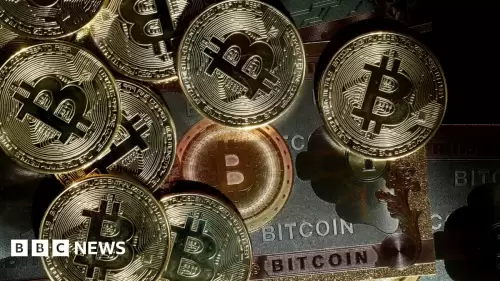 |
|
 |
|
 |
|
 |
|
 |
|
 |
|
 |
|
 |
|
 |
|
 |
|
 |
|
 |
|
 |
|
 |
|
 |
|
Nachrichtenartikel zu Kryptowährungen
What’s Happening in the Crypto Market ?
May 06, 2025 at 08:04 pm

The crypto market experienced a moderate decline of 0.37% over the last 24 hours, according to the latest data from CoinDeFi, extending its downward trend.
This correction comes amidst mixed investor sentiment and ongoing macroeconomic uncertainty. Despite this deceleration, the market capitalization remains high, at 2.89 trillion dollars. However, the critical support level of 2.86 trillion dollars could be threatened if selling pressure intensifies. Such a scenario could potentially lead to further market decline towards the 50-day moving average at 2.74 trillion or possibly to the demand zone at 2.3 trillion if BTC falls below $74,000.
On-chain data provides nuanced insights. According to Glassnode, the Net Unrealized Profit/Loss (NUPL) index of Bitcoin stands at 0.52, reflecting cautious holders without widespread panic.
CryptoQuant notes a 15% decrease in flows to exchanges, suggesting limited selling pressure from retail participants. As tweeted by @CryptoAnalystX on May 5: “Market cap testing support at $2.88T. Low exchange flows + ETF strength = potential rebound.”
This cohort of short-term holders (1-3 months) represents the most aggressive players, including professional speculators trading BTC through ETF brokers. In the current bull cycle, their Net Unrealized Profit and Loss (NUPL) has regularly risen to the >40% range, after which… pic.twitter.com/VIFhUaLR79
According to Axel, on-chain signals are still bullish:
“The current NUPL is at 8%, while its 30-day moving average remains negative and holds at -2%. As long as the NUPL does not exceed 40%, the selling pressure from this cohort will remain minimal, which is a bullish signal.”
This signals that, despite the recent price decrease, these short-term holders are not in a state of panic to sell at a loss.
According to the latest data from the U.S. Congress, Republican lawmakers have introduced a new bill that aims to create a comprehensive framework for digital assets. Building on the FIT21 law passed in 2024, this legislation focuses on reducing market concentration while fostering innovation and consumer protection.
The bill, titled the "Digital Asset and Innovation Enhancement Act of 2024," is a response to the rapid development of the digital asset industry and the need for clear and consistent regulation. It seeks to balance promoting technological advancement with safeguarding investors and the financial system.
The bill also proposes to create a new regulatory body for digital assets, which would be responsible for setting standards, licensing, and enforcing rules. This body would be tasked with coordinating with other federal agencies, such as the Securities and Exchange Commission (SEC) and the Commodity Futures Trading Commission (CFTC), to ensure a coherent regulatory landscape.
The introduction of this bill comes as the SEC is increasing its scrutiny of cryptocurrencies. Last week, the SEC filed lawsuits against both Coinbase and Binance, the largest cryptocurrency exchange in the world. The agency has also been working on approving spot Bitcoin ETFs, which could provide another avenue for institutional investment in crypto.
The new bill is likely to be met with mixed reactions. Some experts believe that it does not go far enough in protecting consumers and could stifle innovation. Others argue that it is a necessary step towards integrating digital assets into the mainstream financial system.
The bill will now be referred to the relevant House committee for further consideration. If approved by both chambers of Congress and signed by the president, it will become law.
The SEC has unveiled the agenda for its upcoming roundtable, set for Thursday at 9:00 AM ET. Notably, the event will be divided into two parts, likely addressing real-world assets (RWA) and broader financial instruments.
“The SEC’s focus on RWAs is significant. Tokenized assets could unlock trillions, which is bullish for the next crypto wave,” writes CryptoLawyer.
This division in the agenda suggests that the SEC is planning to take a broader approach to regulating crypto, considering not only Bitcoin and ether but also other types of digital assets, such as those used in DeFi and Web3.
The SEC’s interest in RWA is also noteworthy, as it could lead to the approval of more crypto products, such as exchange-traded funds (ETFs), which could open up the market to even more investors.
The SEC’s actions will be closely watched by the crypto community, as they could have a major impact on the future of the industry.
Bitcoin price followed the broader downward trend, decreasing slightly by 0.23%. However, despite this decline, Bitcoin spot exchange-traded funds (ETFs) in the U.S. saw new net inflows, indicating persistent institutional interest, even amidst temporary price declines.
The largest net influx came from BlackRock’s iShares Bitcoin
Haftungsausschluss:info@kdj.com
Die bereitgestellten Informationen stellen keine Handelsberatung dar. kdj.com übernimmt keine Verantwortung für Investitionen, die auf der Grundlage der in diesem Artikel bereitgestellten Informationen getätigt werden. Kryptowährungen sind sehr volatil und es wird dringend empfohlen, nach gründlicher Recherche mit Vorsicht zu investieren!
Wenn Sie glauben, dass der auf dieser Website verwendete Inhalt Ihr Urheberrecht verletzt, kontaktieren Sie uns bitte umgehend (info@kdj.com) und wir werden ihn umgehend löschen.
-

-

-

-

- Polizei, Kryptowährung, Bitcoin -Windfall: Unerwartete Gewinne und warnende Geschichten
- Aug 05, 2025 at 01:18 pm
- Von Polizeikräften, die von Bitcoin -Engims bis hin zu Warnungen vor Kryptowährungsbetrug profitieren, befassen wir uns mit der Schnittstelle zwischen Strafverfolgungsbehörden und digitalen Vermögenswerten.
-

-

- Bitmine's Ethereum Treasury: Eine Minute in New York zur Krypto -Herrschaft
- Aug 05, 2025 at 01:01 pm
- Bitmines schnelle Ansammlung von Ethereum hat ein Rennen unter den Krypto -Staatsanleihen ausgelöst, seine Beteiligungen auf über 3 Milliarden US -Dollar vorangetrieben und seine Position als Hauptakteur festigten.
-

-

-






























































